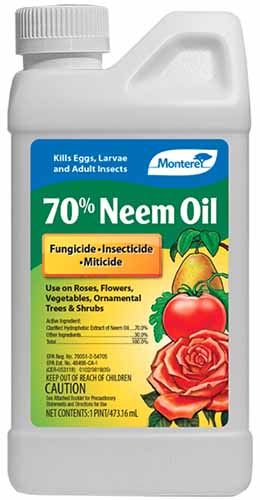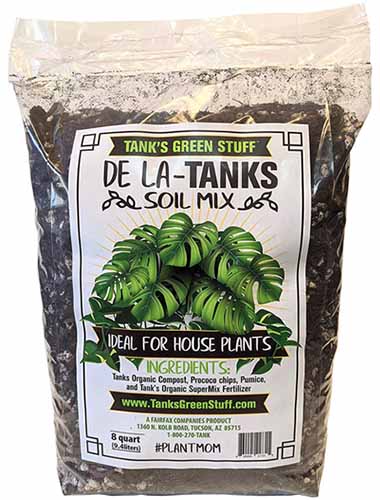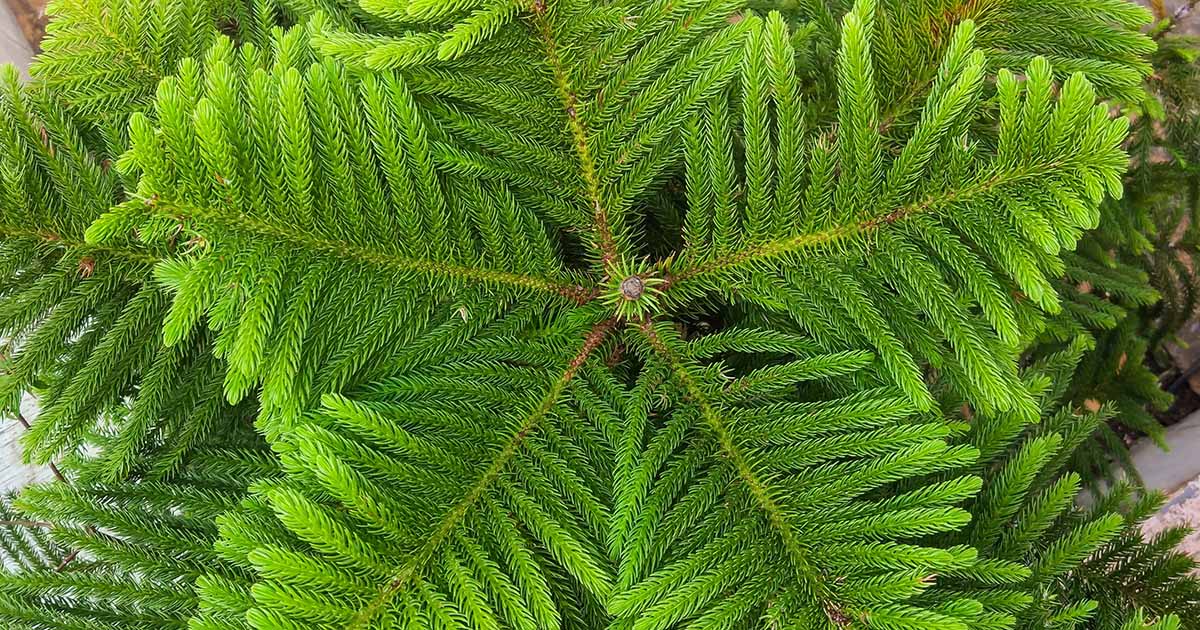
Whether it’s serving you as a living Christmas tree or a long term houseplant, you want your Norfolk Island pine’s foliage to remain evergreen, not showing a display of sad, yellow or brown leaves.
If you’ve noticed discolored, yellow or brown needles on your houseplant, you may be wondering if you let it go too long without water.
But there are other reasons the foliage of these conifer trees can turn unsightly hues!
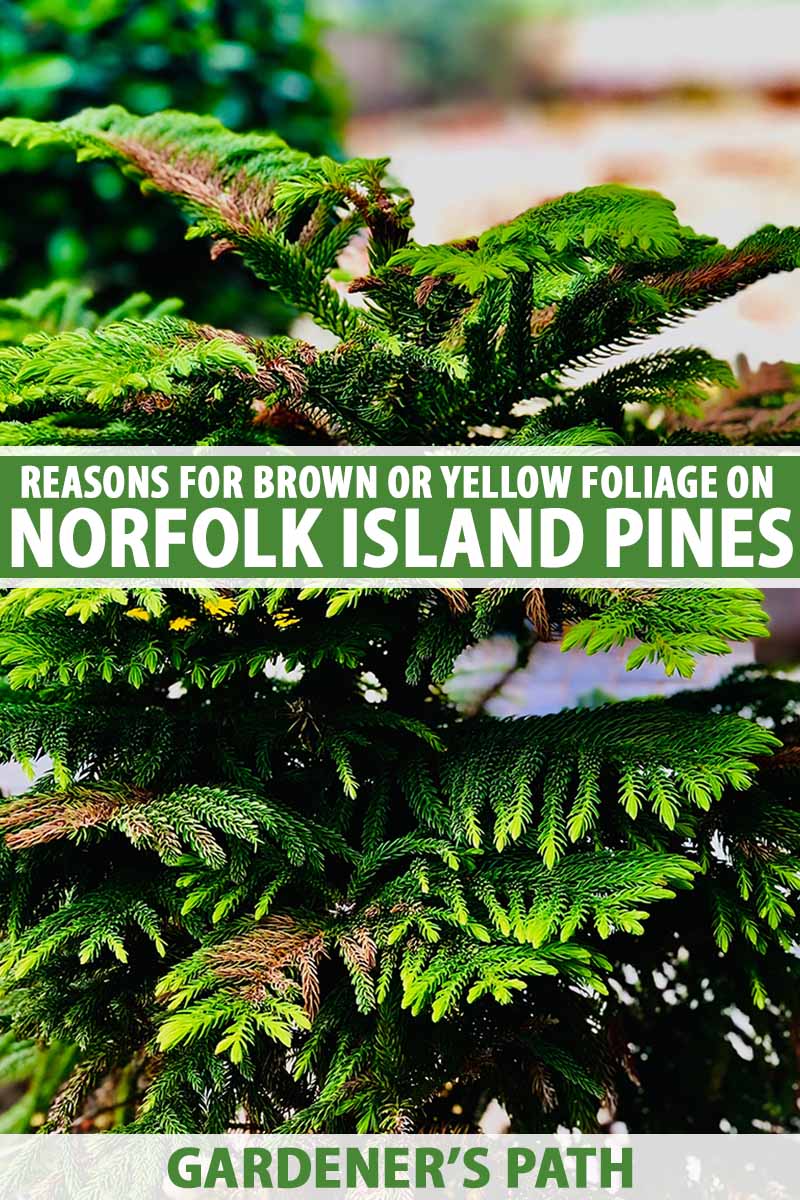
We link to vendors to help you find relevant products. If you buy from one of our links, we may earn a commission.
In this article you’ll learn about 11 causes of yellow or brown leaves on Norfolk Island pines.
By understanding these different reasons for discoloration, you can then choose the right solution to help your tree turn green again.
Ready to learn how to return your tree to its former green glory? Here’s a sneak peek at the list of potential causes of yellow or brown needles:
Discolored Foliage on Norfolk Pines
But before we get started, if you’d like to review growing requirements for these houseplants, be sure to read our complete guide to caring for Norfolk Island pines.
1. Anthracnose
While not the most common reason for brown leaves on Norfolk pines, anthracnose is a fungal disease, caused by Colletotrichum derridis, that can affect these trees leading to discolored foliage.
In addition to causing brown needles, you will also notice black specks on foliage if anthracnose is the problem.
While a definitive diagnosis of anthracnose can only be carried out via analysis in a laboratory, if you think your plant’s brown needles may have been initiated by this fungal organism, there are a few steps you can take.
If possible, remove infected foliage and dispose of it – it can either be buried, or added to a compost bin, as long as the pile heats up to at least 140°F.
You can also apply neem oil to the plant to prevent the spread of the fungus to unaffected branches.
Neem oil is a fungicide, insecticide, and miticide that is safe for use around humans, dogs, and cats.
Monterey neem oil is available for purchase as a concentrate or ready to use in several different sizes from Arbico Organics.
Make sure to follow the manufacturer’s directions for application and keep plants out of direct sun for a few days after applying this product – oil on the plant’s leaves can cause scorching.
As a final step to prevent the spread of anthracnose, avoid watering plants from overhead since damp conditions are favorable for the development of the disease.
2. Direct Sunlight
Norfolk pines can certainly grow outdoors under the direct rays of the sun – as they do in their native environment, and in areas where they have naturalized or are grown as ornamentals.
Yet, for houseplants grown indoors, a sudden shift to full sun can be too much of a good thing, too fast.
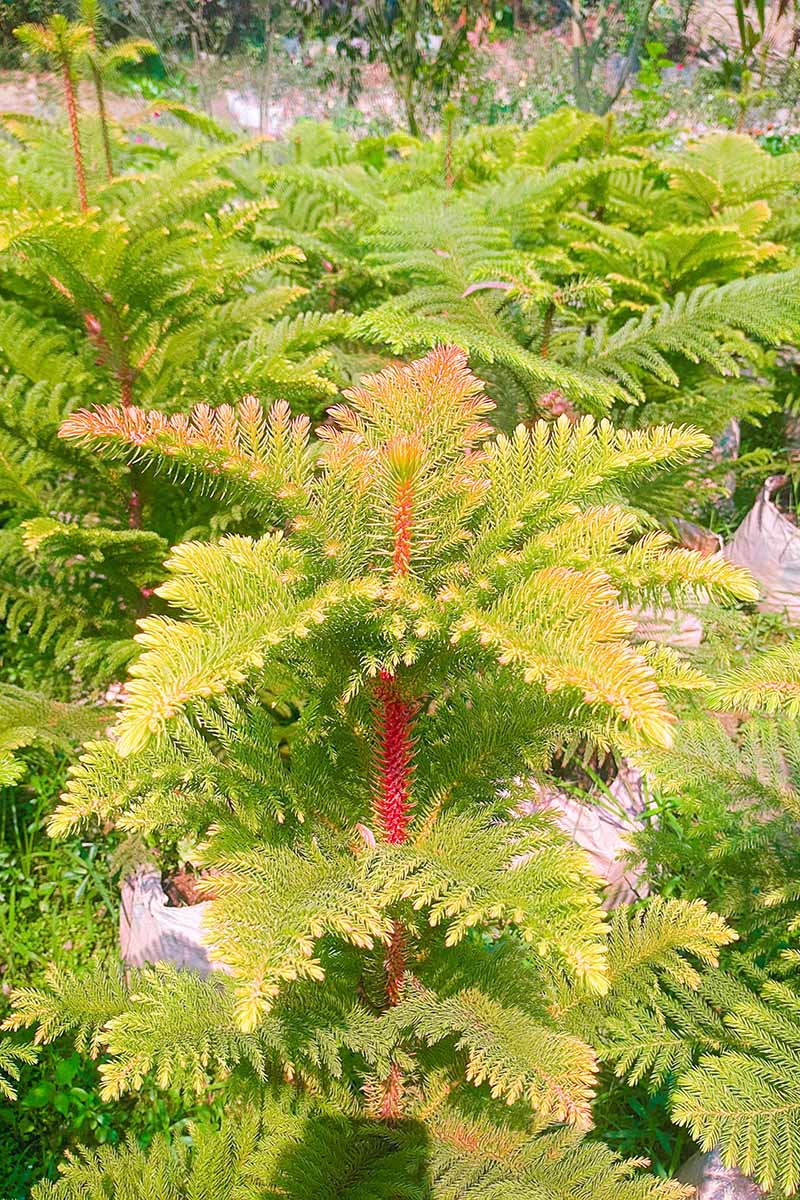
Vulnerable specimens can react to sudden direct sun exposure with scorched brown needles that may have reddish undertones.
To prevent brown leaves caused by sun scorching, gradually introduce the conifer to brighter, more direct light, if that is your goal.
However, direct sun isn’t a requirement for these trees. Bright, indirect light will provide for their needs just fine, and can encourage slower growth, a boon for houseplant parents hoping to keep these plants from bumping up against their ceilings.
3. Cold Temperatures or Drafts
Did you leave your living Christmas tree outdoors on a deck or patio when temperatures dropped in autumn, or perhaps you transferred it outdoors too early in spring?
If so, being exposed to cold weather may have caused the tree’s brown needles.

These conifers prefer temperatures above 50°F, and can be killed by temperatures 35°F or lower. When exposed to temperatures approaching freezing, brown leaves can appear.
But if exposure to chilly outdoor weather isn’t the culprit, check your tree’s location for cold drafts too.
Chimneys can create colder microclimates inside homes, and locations near windows and doors can also be drafty.
The best temperature range for these trees is 60 to 72°F, so keep that as your goal and relocate your conifer if needed.
4. Hot Temperatures
Are you summering your houseplant out of doors?
If so, be wary of heat waves since temperatures over 95°F can damage the plants, causing branch tips and growing tips to react to hot conditions by turning brown.
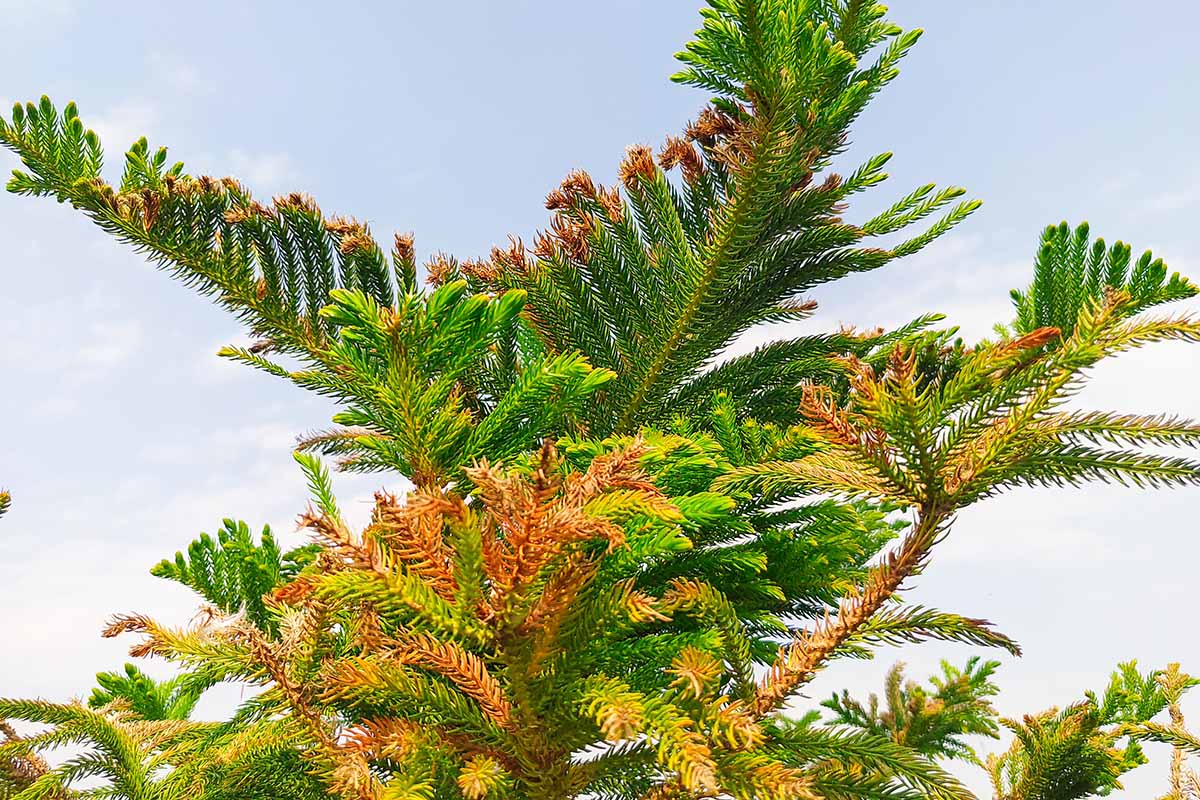
For this reason, it might be best to keep your Norfolk Island pine indoors all year round – which can also help prevent it from outgrowing your home too quickly.
Likewise, when your houseplant is indoors, brown leaves may indicate the plant is in a hot microclimate within your home.
While a living Christmas tree might look cozy next to the fireplace, a fire can radiate heat that may be too toasty for the tree, so prioritize a different location for this houseplant.
5. Low Humidity
Some indoor gardeners may notice brown needles on the growing tips of their living Christmas trees as a result of low humidity.
Wondering what the best air moisture level is for these houseplants? A relative humidity of approximately 50 percent is ideal.
While those in desert locations may experience low humidity levels year-round, inhabitants of other climates can suffer from dry air during winter when heating systems are turned on, causing brown leaves on Norfolk pines.
If you suspect low humidity is an issue in your home, make sure this is the case before using a humidifier, since adding humidity to an already moist environment could cause mold problems.
To test your indoor humidity, you can use an inexpensive humidity meter, also known as a hygrometer, such as this one, which is analog and doesn’t require any batteries or charging:
Mini Analog Hygrometer and Thermometer Combo
You can purchase a two-pack of mini analog hygrometer and thermometer combos from the Wacool Store via Amazon.
If you determine that your indoor humidity levels are lower than 50 percent, you may want to use a humidifier near the plant to help raise the moisture levels in the air.
1.2 Gallon Large Black Humidifier
This large, black humidifier is quiet during operation and holds just over one gallon of water, offering 40 hours of humidification. It’s available for purchase from Rosekm via Amazon.
6. Low Light
Are the branches on your living Christmas tree turning yellow and drooping?
This combination of symptoms indicates that light exposure is too low for the amount of water the plant is being offered.
When these plants are kept as houseplants, bright indirect light with a few hours of direct morning sunlight is ideal.
If you’re not sure whether the light you are providing to your conifer is sufficient, a light meter is a helpful tool that can provide you with objective data about light exposure.
Learn more about using and choosing a light meter in our article.
Norfolk Island pines need at least 400 foot candles of light to thrive, while 200 foot candles will allow them to simply survive. If yours isn’t receiving enough light, try moving it closer to a window, or consider supplementing with a grow light.
If you’re keeping your tree in medium or low light, you may need to reduce the amount of water you provide. Aim to water only when the top inch of the plant’s growing medium is dry.
Keeping a houseplant healthy is primarily about finding the right balance between light exposure and water – when light intensity is lower, watering frequency will also need to be less often.
7. Natural Leaf Shedding
This is one reason for brown leaves that isn’t a cause for concern: natural leaf shedding.
It’s completely normal for a Norfolk Island pine to lose some of its needles.
This process should happen slowly among the oldest branches on the plant.
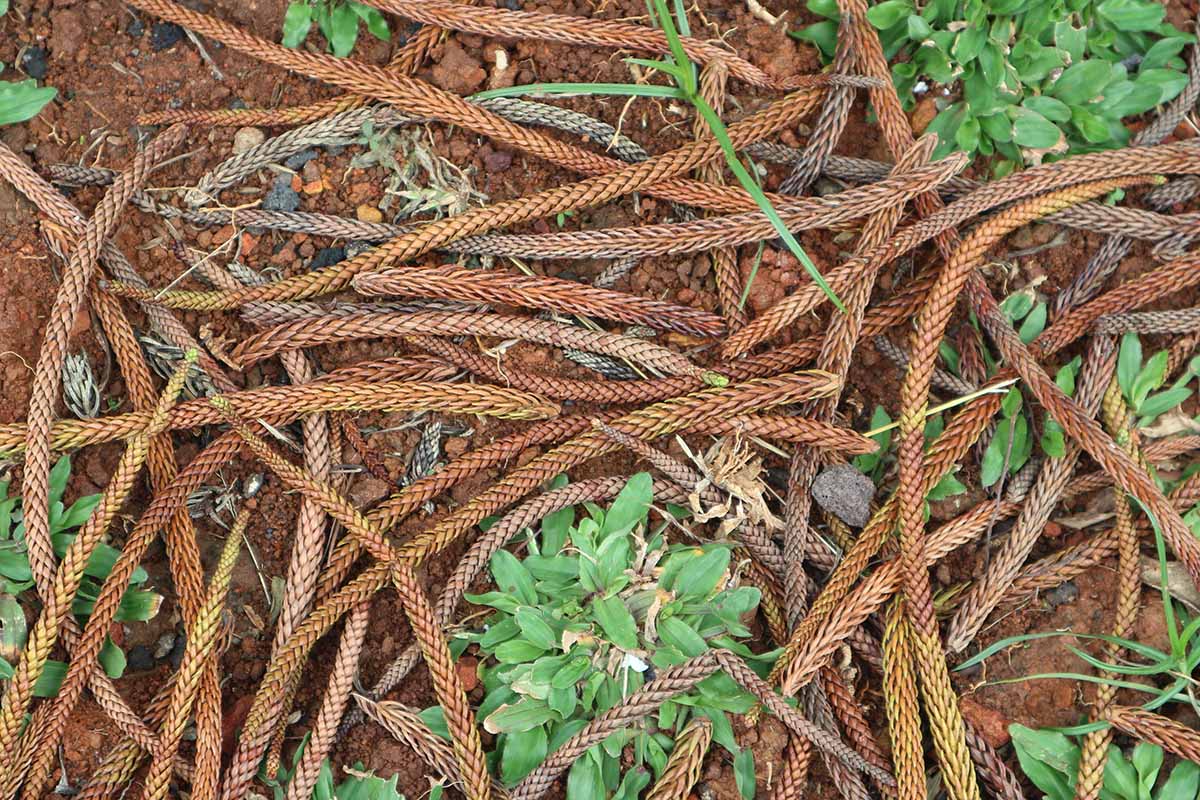
Natural leaf shedding causes brown needles on older branches.
On the other hand, if needles turn brown more quickly or the top branches are affected, it is likely caused by a different issue.
8. Nutrient Deficiency
If your Norfolk Island pine is taking on an overall yellowish cast and is being grown in very bright light or full sun, it may be turning yellow because it is lacking macronutrients and needs more fertilizer. Intense light can increase the plant’s need for nutrients.
To help with this, feed the living Christmas tree with a 3-1-2 (NPK) fertilizer.
On the other hand, if only the branch tips and growing tip of your Norfolk Island pine have turned yellow, a micronutrient deficiency may be the problem.
This can be a problem particularly when these conifers are planted in growing medium with a pH above 7.0.
Most houseplant growing mediums will have a pH of less than 7.0, but if you’re not sure it doesn’t hurt to test it and find out.
Read our article to learn more about the best soil test kits.
If it seems that a nutrient deficiency could be a problem for your houseplant, you may want to feed your houseplant some macronutrients, some micronutrients – or even both.
Luckily, there are products that supply both macronutrients and micronutrients, such as Grow from Mission Fertilizer.
Mission Organic Grow 3-1-2 Fertilizer
Mission Organic Grow 3-1-2 Fertilizer is rich in micronutrients and is available in quart or gallon jugs from Mission Fertilizer via Amazon.
9. Root Rot
Does your houseplant look like it’s dehydrated while its growing medium is still wet? The problem may be root rot.
Root rot can cause yellow or brown leaves on living Christmas trees.
Ironically, too much water is usually the root cause of this disease – pun intended. The excess water starves roots of oxygen, causing them to rot and allowing pathogenic organisms to flourish.
Dead roots fail to take up any water, and the plant starts to dry out, as indicated by its yellow or brown needles.
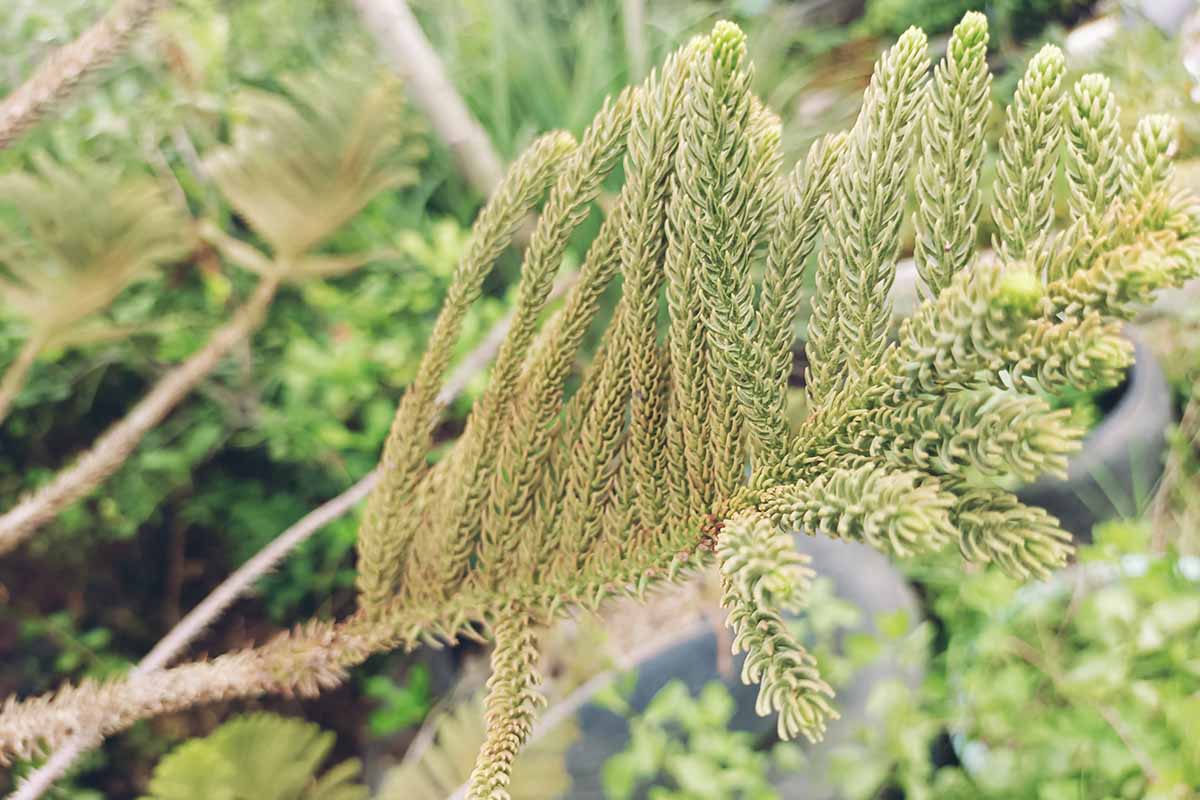
There are different ways that this conifer’s roots can suffer from too much water.
The most straightforward way is when a houseplant parent is overzealous with their watering can, not permitting the soil to dry out enough between waterings.
Make sure to allow the top inch of the growing medium to dry between waterings. For smaller specimens, make that the top half-inch.
If you aren’t the only member in your household, make sure everyone knows the rules about watering houseplants – some well-intended humans tend to empty their half-finished glasses of water in houseplant pots, without realizing this can lead to overwatering.
Another red flag is a pot without drainage holes. Drainage holes help keep the growing medium well-aerated, allowing water to flow through but not stagnate.
If your houseplant’s pot lacks drainage holes, go ahead and repot it, and change out the growing medium while you’re at it.
Need a growing medium recommendation? One of my favorites is De La Tank’s House Plant Mix.
You can purchase De La Tank’s House Plant Mix from Tank’s Green Stuff via Arbico Organics.
Finally, if the Norfolk Island pine is in a pot that is too large, this can lead to a wet, stagnant growing medium. Since the plant’s roots don’t extend far into the soil, the medium is much slower to dry.
If root rot seems to be the problem, just so you know, it can be difficult to bring a plant back from this disease, but it’s always worth a try!
First determine the reason the soil is staying too moist, then unpot the plant and trim any dead, rotting roots, and transplant it into the right sized pot with a well-draining growing medium.
10. Spider Mites
Spider mites are pests that can feed on these conifers, causing brown leaves with an orangish tone.
Hard to spot due to their small size, infestations of spider mites often go unnoticed until webs are formed on the plants.
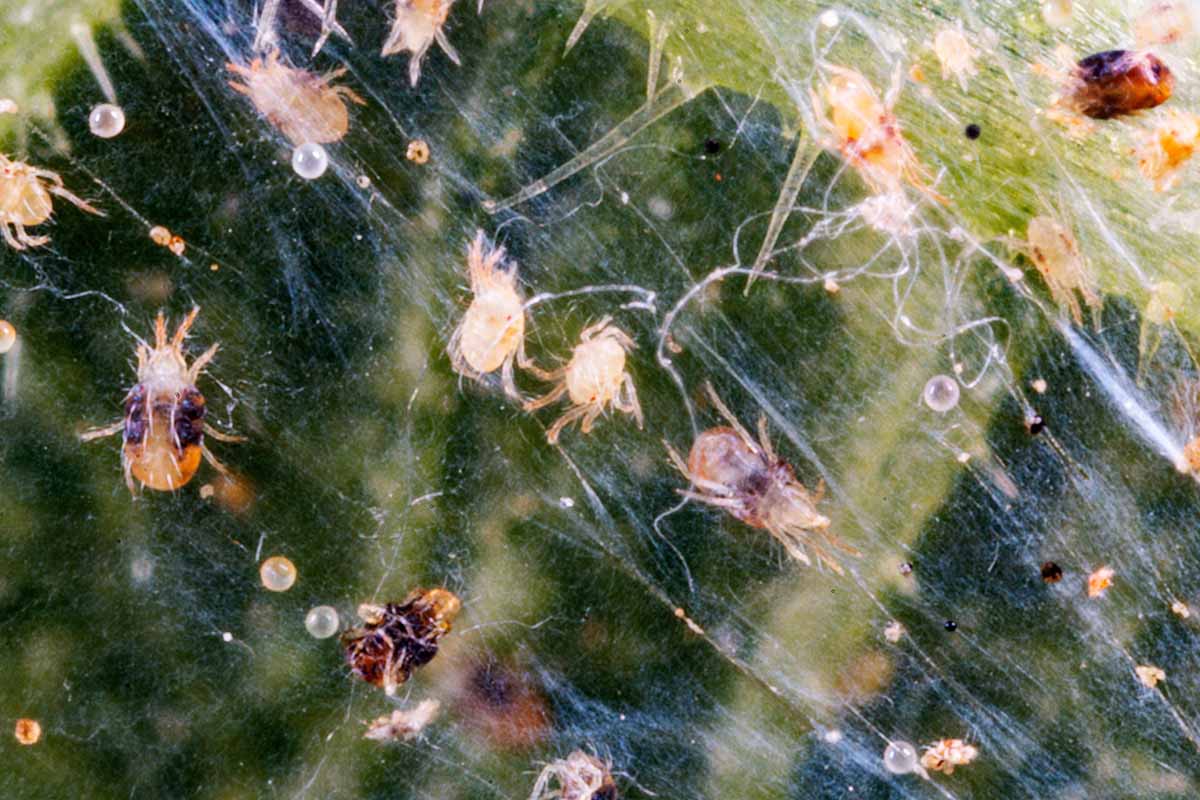
If you detect spider mites on your Norfolk Island pine, don’t worry, there’s a non-toxic solution that’s safe to use inside your home – neem oil, the same product I recommended to prevent the spread of anthracnose.
Neem oil doesn’t kill spider mites directly, instead it interrupts their growth cycle, so you’ll need to reapply this product periodically until the pests are gone.
Be sure to spray the entire plant with the product, and keep the tree out of direct sun for a few days, as mentioned above.
As always, read the manufacturer’s directions before applying.
Learn more about how to deal with spider mites in our guide.
11. Underwatering
Finally, one of the most common causes for brown needles on Norfolk Island pines is underwatering.
If this houseplant is neglected for long enough, it will start to sacrifice its lower branches and eventually the growing tip will also turn brown and die.
While mature specimens can sometimes recover from such ill treatment, younger ones are more vulnerable and are less likely to survive.
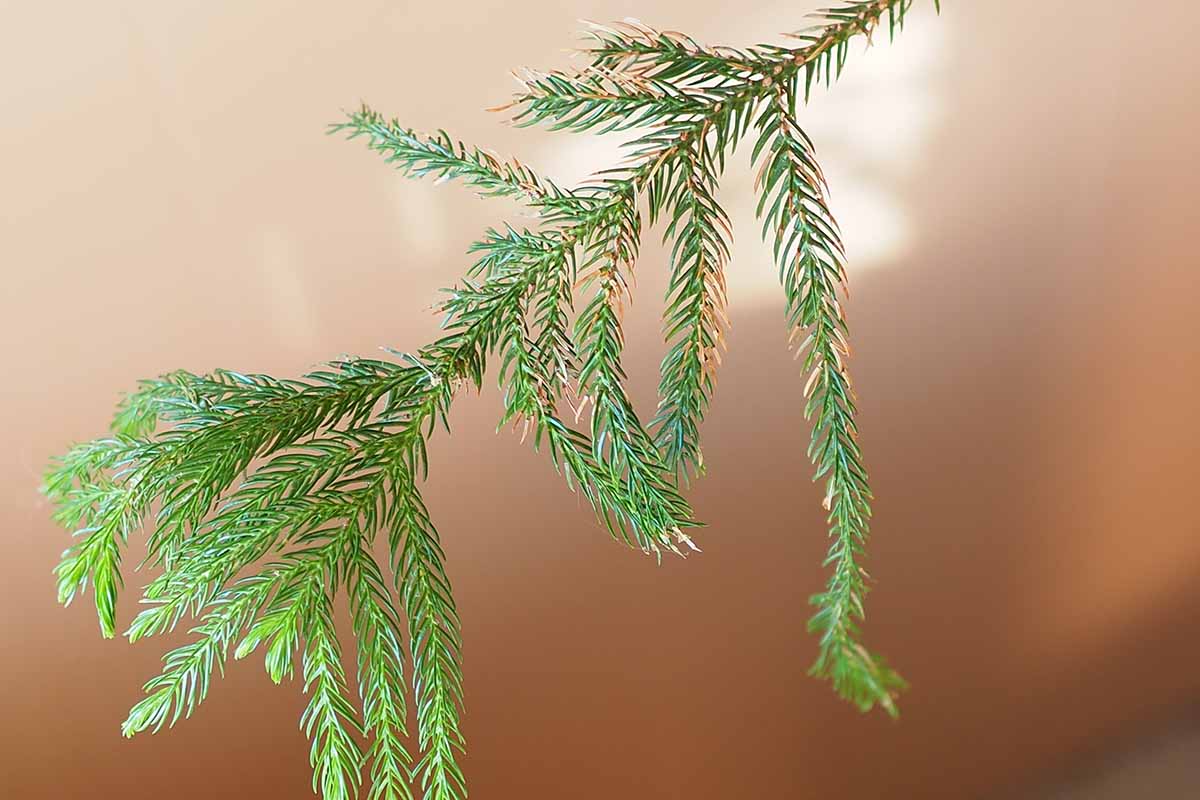
If your conifer has had some of its branches turn brown due to lack of water, trim them off and get the plant back on a good watering routine. Some plants are able to recover and will put out new green branch tips and growing tips.
While some trees will recover from underwatering, it’s not a great idea to test your houseplant’s resilience over and over.
So make sure to water your Norfolk Island pine tree when the top inch of growing medium is dry.
An Ever Green Living Christmas Tree
If this guide has helped you identify the cause of yellow or brown needles on your Norfolk Island pine, hopefully you will now be able to address the problem and return your conifer to its former green glory!

As for those yellow or brown leaves, as long as the entire plant isn’t affected, you can prune off the unsightly tips or branches and allow your houseplant to grow new green ones.
However, avoid removing the growing tip on the top of the plant unless it is brown.
Did this article help you? If so we’d love to know – just leave us a note in the comments section below. And if you still need help troubleshooting a living Christmas tree problem, be sure to upload photos of your houseplant so that we can see what’s going on.
Of course you want to offer the best possible care to your tree, so keep reading about Norfolk pines, right here:
